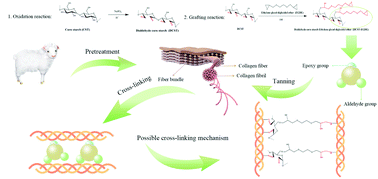Chrome-free tanning agent based on epoxy-modified dialdehyde starch towards sustainable leather making
Abstract
Deleterious effects of Cr6+ on humans and the environment have attracted widespread attention worldwide, compelling the leather industry to urgently search for an eco-friendly tanning agent that can replace chromium. In this study, ethylene glycol glycidyl ether (EGDE) was grafted onto dialdehyde corn starch (DCST) with an oxidation degree of 91% and the terminal epoxy group was retained to synthesize a biomass-based chrome-free tanning agent (DCST-EGDE). Gel permeation chromatography (GPC) results revealed that the weight average molecular weight (Mw) of DCST-EGDE is reduced to 1143 compared with that of raw corn starch (CST), which can satisfy the requirements for a tanning agent used for making leather. Scanning electron microscopy (SEM), X-ray diffraction (XRD), Fourier transform infrared (FTIR) spectroscopy, 1H Nuclear magnetic resonance (1H NMR) and X-ray photoelectron spectroscopy (XPS) revealed that EGDE is successfully grafted onto the C6-OH of DCST and that the terminal epoxy group is retained. The epoxy value of DCST-EGDE reached 0.284 mol per 100 g. The shrinkage temperature (Ts, 85.2 °C), mechanical properties, and whiteness of the leather tanned by DCST-EGDE were considerably improved in comparison with those of the leather tanned by DCST. Compared with leather tanned by the most widely used tanning agents of F-90 and TWS on the market, its comprehensive performance also exhibited more advantages. Therefore, DCST-EGDE is expected to become a new biomass-based ecological chrome-free tanning agent to replace chromium.

- This article is part of the themed collection: 2021 Green Chemistry Hot Articles


 Please wait while we load your content...
Please wait while we load your content...